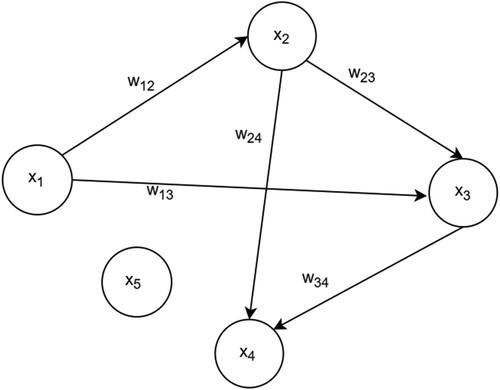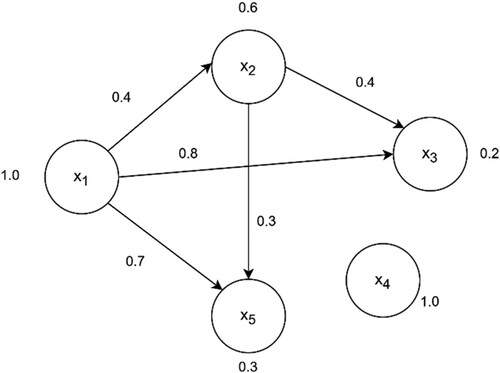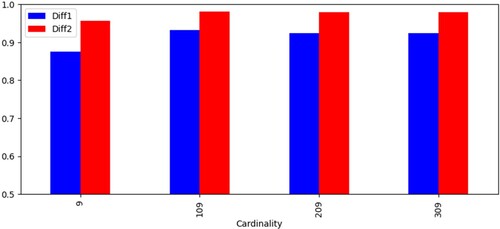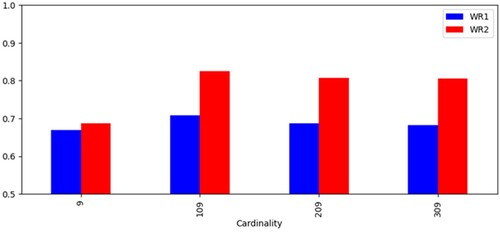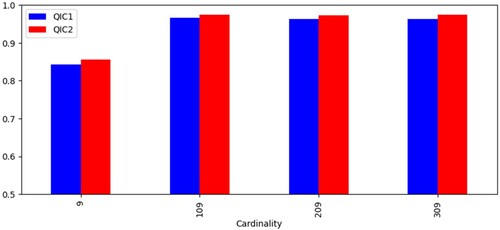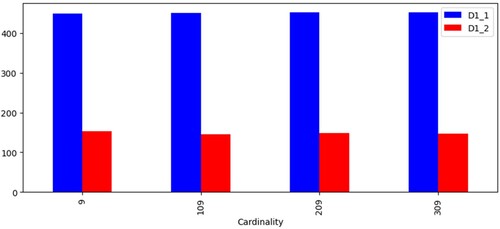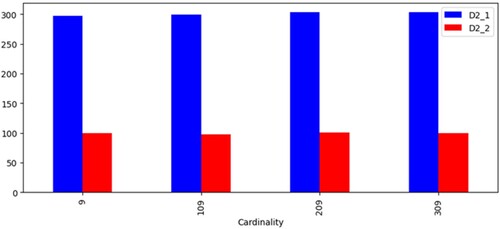 ?Mathematical formulae have been encoded as MathML and are displayed in this HTML version using MathJax in order to improve their display. Uncheck the box to turn MathJax off. This feature requires Javascript. Click on a formula to zoom.
?Mathematical formulae have been encoded as MathML and are displayed in this HTML version using MathJax in order to improve their display. Uncheck the box to turn MathJax off. This feature requires Javascript. Click on a formula to zoom.ABSTRACT
Collective intelligence refers to the ability of groups to problem-solving, and decision-making. Such ability is not often exhibited when group members act individually. In addition, collective intelligence is interdisciplinary research involving biology, psychology, computer science, complex sciences, cognitive studies, etc. In recent years, the rapid development of social media has significantly changed how humans interact and communicate with each other. Accordingly, many research results have shed light on how social media fosters collective intelligence. This paper presents an approach to enhancing the collective intelligence of crowds based on providing a small expert’s knowledge related to the given problem. In addition, collective members are inspired by individuals on social networks. For such a task, graph theory is used to represent the relationship between collective members. Computational experiments have been carried out showing the positive role of the proposed method in enhancing collective intelligence. Finally, we discuss some further issues on improving the collective intelligence of crowds.
Introduction
Generally, collective intelligence refers to the ability of groups of uninformed members to problem-solving (Lee & Jin, Citation2019) and decision-making (Hansen & Vaagen, Citation2016). Extensive research results argue that crowds possess essential collective intelligence benefits, even if using a crowd of uninformed members (Arima, Citation2021; Kameda et al., Citation2022; Zhao et al., Citation2020). Moreover, the collective intelligence of crowds even exceeds the best individual in the crowd at a high probability. This phenomenon is based on the concept that individuals working collectively can achieve more than individuals working alone and collective knowledge integrated from individual knowledge is often greater than the sum of their members (Maleszka & Nguyen, Citation2015).
In the current literature, we can find a variety of collective intelligence-based applications in many sectors including education (Cooke & Teichmann, Citation2012; Meza et al., Citation2018), healthcare (Radcliffe et al., Citation2019), prediction markets (Bottazzi & Giachini, Citation2019; Palak & Nguyen, Citation2017), sociology (Kameda et al., Citation2022), psychology (Woodley & Bell, Citation2011), complex systems (Woodley & Bell, Citation2011), climate changes (Nik & Moazami, Citation2021), organization of science (Woolley & Fuchs, Citation2011). Due to the variety of its application sectors, there exist many similar terms such as wisdom of crowds (Surowiecki, Citation2005), group intelligence (Williams & Sternberg, Citation1988), vox populi (Galton, Citation1907), collective mind (Radcliffe et al., Citation2019), or organization mind (Sandelands & Stablein, Citation1987). Besides, definitions of collective intelligence are also various depending on the application sectors. Among them, the most popular one is defined by Levy (Citation1997), Russell (Citation2000), and Nik (Nik & Moazami, Citation2021). Accordingly, collective intelligence is considered as a type of intelligence achieved from the collaboration and competition between individuals in a group. According to Malone and Bernstein (Citation2015), collective intelligence is considered as groups of individuals who collectively do things that seem intelligent (Malone & Michael Bernstein, Citation2015).
A large body of literature has revealed the major characteristics that guarantee collectives to be intelligent are diversity, independence, decentralization and aggregation (Surowiecki, Citation2005). Besides, knowledge plays a significant role in improving collective performance (Simmons et al., Citation2011). Concretely, unreliable, or biased solutions will be reduced if collective members have knowledge related to the problem that needs to be solved. According to Sassi et al (Citation2022), knowledge can foster innovation which is helpful in problem-solving.
Recently, advanced internet and social media technologies have facilitated individuals to connect and collaborate, leading to an explosion of new applications for collective intelligence. Therefore, collective intelligence can be harnessed in many forms including online communities, crowdsourcing, collaborative problem-solving, and social networks. According to Passig & Zoref (Citation2020), social networks are considered as a platform for exploiting the collective intelligence of crowds.
In the current literature, the improvement of the collective intelligence of crowds is mainly based on the characteristics introduced by Surowiecki (Citation2005). Among them, diversity is widely investigated in improving collective intelligence. However, there exists another important characteristic called knowledge because having knowledge related to a given problem will be helpful in reducing unreliable or biased predictions. Such a role of knowledge has been documented in many publications (Nofer & Hinz, Citation2014; Budescu & Chen, Citation2014), in (Silver et al., Citation2021), even in the case of prediction markets – a well-known application of collective intelligence (Bossaerts et al., Citation2024). In addition to the current literature, this paper investigates an approach to improve the collective intelligence of crowds by providing a small amount of knowledge related to the problem that needs to be solved. For such a task, graph theory is utilized to represent the relationship between collective members. Then, computational experiments are carried out showing the efficiency of the investigated approach to improving collective intelligence of crowds using different sizes of collective members.
The remaining part of the paper is structured as follows. Next section presents some related works of collective intelligence and its applications. Then, some basic notions have been introduced in the third section. Next section describes the investigated problem and computational experiments as well as their analysis. Some conclusions and future research are mentioned in the last section.
Related works
To date, many research results have investigated the characteristics of collective intelligence (i.e. diversity, independence, decentralization, and aggregation) and its applications to find more accurate predictions of future events. In this section, we summarize the role of these characteristics in enhancing collective intelligence.
Referring to diversity, two kinds of diversity are often taken into consideration in determining its role in collective intelligence (Nguyen & Nguyen, Citation2018b). For a given problem, several individuals are asked to provide their solutions. In this case, diversity can be considered as the difference between individuals of a collective (i.e. viewpoints, profiles, …) (Bhatt et al., Citation2017; Hong et al., Citation2020). In addition, the diversity of individual solutions is often taken into consideration in much research (Hong & Page, Citation2004; Nguyen et al., Citation2017; Nguyen & Nguyen, Citation2018a).
Bhatt et al. studied the relationship between the diversity of collective members (in Twitter) and collective performance by considering the semantic analysis of their social media communications (Citation2017). The diversity of collective members is measured based on the pairwise distance between tweets vectorized by Word2Vec. By considering the performance of diverse collectives, non-diverse collectives, and randomly selected collectives, the means of experimental analysis, diversity positively influenced collective performance in comparison to non-diverse and randomly selected collectives. Experiments conducted in the domain of fantasy sports have shown the positive role of diversity in improving collective performance. The diverse crowds outperform non-diverse and randomly selected crowds. However, the paper did not consider the number of participants in crowds and methods for crowd selection. Later, Bhatt et al. investigated the selection of smart collective by considering the diversity of individual communication and collective size (Citation2019). The obtained results have confirmed that a smart collective can be determined via characterizing, clustering, and sampling participants. Smart collectives are superior to large collectives including randomly selected participants.
In the current literature, an effective approach to fostering the diversity of a collective is increasing its members (Nguyen & Nguyen, Citation2018a). Since the diversity of members and solutions will be potentially diverse in the case of increasing the collective cardinality. Referring to Pescetelli et al. (Citation2020), collective intelligence will be significantly enhanced by the diversity of large collectives (≈25 members) but reduced by the diversity of small ones (≈ 5 members). However, using large collectives does not always significantly improve the quality of collective prediction (Dezecache et al., Citation2022) because there exists a social influence that undermines the collective intelligence of crowds.
Regarding independence, collective members are free to provide their solutions to a given problem. There exist many research works investigating its impact on collective intelligence. Hong et al. (Citation2016) have investigated how the independence of participants in the online investment community influences collective performance. The measure of independence is based on the number of following/followers. The experimental results have revealed the positive role of independence in enhancing the collective intelligence of participants.
Hong and colleagues have also found a similar finding on the impact of independence on collective performance (Citation2020) by taking into account two additional characteristics including diversity and decentralization. To measure the independence of a collective, individual postings of the same stock are used, and the accuracy of collective predictions is used for collective performance measures. In 2018, Bernstein et al. found that besides improving collective performance, the independence of collective members is also helpful in improving the best individual solution (Bernstein et al., Citation2018). Referring to Palak et al., the independence of collective members is measured by taking into account individual profiles (Palak & Nguyen, Citation2019a). Accordingly, the authors investigated some basic analysis of the proposed measure. Later, computational experiments have been carried on to determine the impact of independence on the collective intelligence of experts (Palak & Nguyen, Citation2019b).
In 2021, research results investigated by Sitarczyk et al. confirmed the positive role of independence on collective intelligence in the case of multi-agent systems (Sitarczyk & Nguyen, Citation2021). Accordingly, graph theory is used for representing the relationships between collective members and the independence is measured by taking into consideration the strength of these relationships. In 2022, Nguyen et al. investigated the impact of independence on collective performance (Nguyen & Truong, Citation2023). Computational experiments have been conducted to determine the relationship between independence level and collective intelligence. The findings reveal the positive role of independence in the case of small collectives. Conversely, such a role was not exposed in the case of large collectives.
Decentralization reflects the ability of collective members to specialize and draw on local knowledge. In Palak & Nguyen (Citation2021), authors investigate proposing measures of collective decentralization. For such a task, postulates for the measures have been proposed and analysed. These postulates are considered as useful tools for introducing new decentralization measures. The last characteristic is a suitable mechanism that aims at integrating individual solutions, and knowledge to form a collective one.
From these analyses, most research results mainly investigated methods for enhancing collective intelligence by taking into account collective characteristics. However, there exists another important factor that could be considered is knowledge. Simons and colleagues have argued that for collectives to be intelligent they should satisfy knowledge, motivation, diversity, and independence (Simmons et al., Citation2011). The knowledge is essential because members who have knowledge related to the given problem will be helpful in reducing unreliable or biased predictions provided by anonymous members. Taking into account these criteria, Nofer et al. have investigated the impact of opinion independence and diversity on the crowd performance of stock predictions (Nofer & Hinz, Citation2014). The findings in (Budescu & Chen, Citation2014) have indicated that collective solution of more knowledgeable members outperform that of crowds. Similarly, in Silver et al. (Citation2021) the positive role of knowledge in fostering collective intelligence of groups has been documented. Accordingly, the authors have conducted experiments with 676 diverse members including students, staff, and local community members. In the case of prediction markets – a well-known application of collective intelligence, it is a powerful tool to make accurate predictions about the outcome of an event and, for this reason, they attract the interest of researchers and practitioners alike (Restocchi et al., Citation2019). In Bossaerts et al. (Citation2024), the aggregation of diverse knowledge is helpful in providing more accurate forecasts on future events. Indeed, knowledge related to the given problem is helpful for collective members in reducing unreliable or biased solutions.
Basic notions
In this section, we present the fundamental concepts used in the paper including collective representation, diversity measures, and collective intelligence measures.
Collective representation
In the following section, a collective involving a set of individuals is represented as a weighted directed graph.
Definition 1.
Let be a collective involving n members, the relationship between collective members is described by the following graph:
(1)
(1)
For a given problem, a collective involving n members is asked to provide individual solutions. Suppose that there exists a ground truth of the given problem (r) which is not known in advance by collective members.
Definition 2.
Let be a set of individual solutions provided by collective members in
;
be the representation of individual solutions in collective X.
In order to determine the collective solution, criteria O1 and O2 are used (Nguyen, Citation2002). A collective solution is satisfied:
criterion O1: if
criterion O2: if
where and
.
In addition, we suppose that collective members have their own personal characteristics (called profiles) such as individual backgrounds, and communication with other members, … The weight values between collective members represent the influence of one member on another. A collective of 5 members is described in .
According to , x1 is not influenced by any members in X, and x2 is influenced by x1. Meanwhile, x3 is influenced by both x1 and x2; x4 is influenced by both x2 and x3. In addition, member x5 is not influenced by any members of the collective. Therefore, it has no connection with other members of collective X.
Diversity measure
As aforementioned, the diversity of a collective can be measured by considering the profiles of collective members (Nguyen & Sobecki, Citation2003) and the individual solutions (Nguyen & Nguyen, Citation2018a). In this work, we take into account the variety of individual solutions (P) to measure the diversity level of a collective. The first measure is based on the difference between individual solutions.
(2)
(2) where n represents the number of the collective X and
represents the difference between solutions given by members xi and xj.
The second measure is defined by considering the difference between individual solutions and a collective one.
(3)
(3)
Collective intelligence measure
In this paper, we consider three measures of collective intelligence. In some sense, these measure the performance of collective members as a whole in problem-solving, and decision-making. The first measure takes into account the accuracy of collective solution (Nguyen & Nguyen, Citation2018a). The second one represents the number of times in which collective solution is better than individual solutions (Nguyen & Nguyen, Citation2017). The last one is based on collective error and individual errors (Kawamura & Ohuchi, Citation2000). Concretely, the measures of collective intelligence are as follows:
(4)
(4) where
(5)
(5) where
(6)
(6) where
because
.
In the remainder of the paper, both terms (collective intelligence and collective performance) are often used interchangeably.
A new method for enhancing collective intelligence
In the current literature, many approaches have been proposed to enhance collective intelligence of crowds. Most of the research results focused on analysing the role of collective characteristics introduced by Surowiecki (Citation2005) in collective intelligence. Among these characteristics, diversity plays a crucial role in improving collective performance. Besides, providing a small amount of knowledge related to the problem that needs to be solved (called expert’s knowledge) could be considered as an effective approach (Nguyen et al., Citation2022). Thus, in this paper, we conducted computational experiments to find the role of expert’s knowledge in enhancing collective intelligence. For such a task, the investigated problem is described in . The measures of collective intelligence are based on the quality of collective solution (called collective performance).
In the simulation procedure, we first generate collective members and a set of individual solutions based on their reputation values. Then, the collective solution which is representative of these individual solutions is determined by using criterion O2. After that, collective members modify their solutions based on the received expert’s knowledge related to the given problem. Again, a collective solution is determined on the basis of these modified solutions. Finally, we compare the quality of these collective solutions by taking into account the aforementioned measures.
The pseudocode of the proposed method is described in Algorithm 1.
In the following section, the expert’s knowledge is assumed as the solution provided by an expert. Then, collective members will update their solutions based on the provided solution.
In order to propose a mechanism for updating individual solutions, we consider the following assumption:
All members receive the same expert’s solution which is used for reconsidering their solutions.
An expert’s solution is the one provided by the high reputation member.
If an individual solution is identical to the expert’s solution, then it is not necessary to update its solution.
Members having higher reputation values tend to retain as much as possible their solutions instead of modifying them based on the expert solution.
From these assumptions, we introduce an updating mechanism for collective members to modify their individual solutions based on the mechanism proposed in (Wu & Xu, Citation2012).
Definition 3.
Member updates individual solutions based on the expert’s solution using the following formula:
(7)
(7)
Example 1.
For a given collective involving 5 members X = {(x1:1.0), (x2:0.6),(x3:0.2),(x4:1.0),(x5:0.3)}. Let P = {100, 200, 300, 200, 100} be their individual solutions to a given problem:
According to , members are assigned a value belonging to [0, 1] which represents their reputation levels. These values are utilized to compute the influence of a member on others.
Suppose the expert solution is 200, then individual solutions of members in Example 1 will be updated as in .
Table 1. Updating individual solutions.
Computational experiments
Settings
In this paper, we use the simulation environment as in the previous work (Nguyen & Truong, Citation2023). We suppose that for a given prediction task the potential solutions provided by collective members belong to a predefined range. For such an assumption, we define a maximal difference between individual solutions and the ground truth of a given problem.
Let be a set of potential solutions of a given problem,
be a predefined threshold representing the maximal difference,
be an individual solution
, then
. In this paper, we use
, and the ground truth (r) is 1000. Then, U is described as follows:
Apart from these, collective members are associated with different reputation values representing their background, and knowledge of the given problem. We suppose that collective members with higher reputation levels will provide more accurate solutions than those with lower reputation levels. The more accurate solutions mean the closer ones to the ground truth. For such an assumption, the potential solutions of collective members with different levels of reputation are described in the following table.
According to , we group reputation values into three categories involving low level (L1), medium level (L2), and high level (L3). These reputation categories are also utilized for simulating individual solutions provided by collective members. Reputation values of collective members will be followed by uniform distribution. Later, these values are used to compute the weights of edges connecting collective members in the graph. Moreover, the connections between collective members are based on Erdos Renyi (Erdős & Rényi, Citation1960).
Table 2. Ranges of different reputation levels.
The individual solutions of collective members are followed by uniform distribution. Members with lower reputation values will have a larger solution range in comparison to those with higher reputation values. In addition, we assume that an expert is the one having the highest reputation level (L3). For such an assumption, the expert’s solution will be randomly chosen from the interval [750, 1250].
In the following section, we carried out computational experiments with different cardinalities of collectives (i.e. 9, 109, 209, and 309). Criterion O2 is used to compute collective solution (Nguyen, Citation2002). For each setting, we repeatedly run 100 times, and the mean results from these runs are recorded.
Experimental results and their analysis
In the following table, we used three measures of collective performance. Concretely, Diff1 and Diff2 represent the Diff values of collectives before and after modification of individual solutions based on the expert’s solution (similar to WR and QIC measures).
The collective performance values described in are the average of corresponding values since we repeated 100 times for each setting.
Table 3. Simulation results.
According to , the values of Diff2 are slightly higher than those of Diff1. Collective performance in this case increases by around 5%. Meanwhile, collective performance in terms of WR measure increases by around 12% (highest). The values of WR2 are significantly higher than those of WR1. However, in terms of QIC measure, the collective performance is not much improved (around 1%).
Referring to , in the case of Diff measure, the modification of collective members based on the expert’s solution can lead to higher collective performance.
In terms of WR measure (see ), the collective intelligence is significantly enhanced as modification of individual solutions based on the provided expert’s solution. The collective solution can be superior to individual solutions at a higher ratio. In other words, the quality of collective solution is considerably improved in comparison to Diff and QIC measures.
According to QIC measure (see ), we also found that collective performance increases as members modify their solutions based on the expert’s solution.
Further, to verify the difference between samples of collective performance with each measure, we perform Kruskal–Wallis test because the obtained results do not come from a normal distribution (based on Shapiro–Will test). In addition, the significance level of 0.05 is used for all statistical tests ().
Table 4. Kruskal–Wallis test results.
According to Kruskal–Wallis test, the difference between samples of collective performance with larger collective sizes (i.e. 109, 209, 309) is statistically significant for all measures (all p-values are less than 0.05). In the case of collectives of 9 members, the statistical results are only statistically significant in terms of Diff measure. However, with WR and QIC we do not find any statistical significance. For more details, we consider the change in diversity values of collectives after modifying individual solutions based on the expert’s solution in comparison to the diversity values of generated collectives (see ).
Table 5. Diversity levels of collectives.
According to , with collectives of 9, the diversity value reduces from 499.7790 to 152.7373 in the case of D1 measure. Meanwhile, in the case of D2 measure, the diversity value decreases to 99.6590 from 297.0780. The diversity of collectives changes rapidly when their members modify individual solutions based on the provided expert’s solution in terms of D1 and D2 measures (see and ).
From these results, it can be concluded that providing expert’s knowledge (i.e. expert’s solution) is an effective approach to improving collective performance in terms of Diff and WR measures. Apart from these, the diversity of collectives is also rapidly decreased for both D1 and D2 measures.
Another issue with the conclusion in this work is Whether it is contrary to the previous results on the positive role of diversity in collective performance?. In fact, most research results did not take into account different solution ranges for collective members as in Nguyen and Nguyen (Citation2018a). Therefore, when all individual solutions are in the same solution range, then the more diverse solutions will lead to a more accurate collective solution.
Conclusion and future work
Collective intelligence refers to the ability of groups to problem-solving, and decision-making. Such ability is not often exhibited when group members act individually. To date, collective intelligence has been widely applied to find predictions of future events. There exist many approaches proposed to enhance the collective intelligence of crowds by considering the characteristics of crowds. This paper presents an approach to improving the quality of collective performance by providing a small amount of knowledge related to the given problem (called expert’s knowledge). For such a task, computational experiments have been conducted to determine how the proposal influences collective performance. The findings indicate that providing expert’s knowledge plays an important role in enhancing collective intelligence of crowds. Moreover, this approach also causes the diversity of individual solutions to be decreased and reduces unreliable or biased solutions. Although these results were obtained in a simulated environment, they are considered as a basis for further research on enhancing collective intelligence of crowds.
For future work, we intend to investigate the impact of other collective characteristics such as decentralization on collective intelligence. We also investigate collective formation which is also an important problem in fostering the collective intelligence of crowds. The impact of collective members’ diversity on collective intelligence also investigated by taking into account the proposed model (Duong, Nguyen, and Jo Citation2010).
Acknowledgements
This research is funded by Vietnam National University Ho Chi Minh City (VNU-HCM) under grant number DS2021-26-03.
Disclosure statement
No potential conflict of interest was reported by the author(s).
Additional information
Funding
Notes on contributors
Hai Bang Truong
Hai Bang Truong has finished his Ph.D. in Computer Science at University of Information Technology, Vietnam National University, Ho Chi Minh City, Vietnam. His research interests are consensus method, knowledge integration, collective intelligence. He has published 21 papers (6 publications in Web of Science Core Collection, 15 publications in prestigious conferences). He is the principal investigator of two projects by University of Information Technology, Vietnam National University, Ho Chi Minh City, Vietnam.
Van Du Nguyen
Van Du Nguyen is with Nong Lam University, Ho Chi Minh City, Vietnam as a lecturer. He received MSc. and Ph.D. in Computer Science at Wroclaw University of Science and Technology, Poland. His research interests are consensus method, swarm intelligence, and collective intelligence. He has published 34 papers (13 publications in Web of Science Core Collection, 2 publications in ESCI and Scopus, 19 publications in prestigious conferences). He is the principal investigator of two projects by Nong Lam University Ho Chi Minh City, Vietnam; member of three projects by Nong Lam University Ho Chi Minh City, Vietnam and University of Information Technology, Vietnam National University, Ho Chi Minh City, Vietnam; Member of the project S2013/ICE-3006 SICOMORo-CM, by Universidad Complutense de Madrid, Spain. From 06/2016 to 08/2016, he was a visiting researcher at Yeungnam University, Korea.
References
- Arima, Y. (2021). Group collective intelligence. In Y. Arima (Ed.), Psychology of group and collective intelligence (pp. 95–119). Springer International Publishing.
- Bernstein, E., Shore, J., & Lazer, D. (2018). How intermittent breaks in interaction improve collective intelligence. Proceedings of the National Academy of Sciences, 115(35), 8734–8739. https://doi.org/10.1073/pnas.1802407115
- Bhatt, S., Chen, K., Shalin, V. L., Sheth, A. P., & Minnery, B. (2019). Who should Be the captain this week?Leveraging inferred diversity-enhanced crowd wisdom for a fantasy premier league captain prediction. Proceedings of the International AAAI Conference on Web and Social Media, 13, 103–113. https://doi.org/10.1609/icwsm.v13i01.3213
- Bhatt, S., Minnery, B., Nadella, S., Bullemer, B., Shalin, V., & Sheth, A. (2017). Enhancing crowd wisdom using measures of diversity computed from social media data, pp. 907–913. Proceedings of the International Conference on Web Intelligence, WI ‘17, Leipzig, Germany, 23-26 August 2017.
- Bossaerts, F., Yadav, N., Bossaerts, P., Nash, C., Todd, T., Rudolf, T., Hutchins, R., Ponsonby, A.-L., & Mattingly, K. (2024). Price formation in field prediction markets: The wisdom in the crowd. Journal of Financial Markets, 100881. https://doi.org/10.1016/j.finmar.2023.100881
- Bottazzi, G., & Giachini, D. (2019). Far from the madding crowd: Collective wisdom in prediction markets. Quantitative Finance, 19(9), 1461–1471. https://doi.org/10.1080/14697688.2019.1622285
- Budescu, D. V., & Chen, E. (2014). Identifying expertise to extract the wisdom of crowds. Management Science, 61(2), 267–280. https://doi.org/10.1287/mnsc.2014.1909
- Cooke, N. A., & Teichmann, J. J. (2012). 9 – Keeping current. In N. A. Cooke & T. I. P. Teichmann (Eds.), Chandos information professional series (pp. 99–116). Chandos Publishing.
- Dezecache, G., Dockendorff, M., Ferreiro, D. N., Deroy, O., & Bahrami, B. (2022). Democratic forecast: Small groups predict the future better than individuals and crowds. Journal of Experimental Psychology: Applied, 28(3), 525–537. 10.1037xap0000424
- Duong, T. H., Nguyen, N. T., & Jo, G. (2010). Constructing and mining a semantic-based academic social network. Journal of Intelligent & Fuzzy Systems, 21(3), 197–207. https://doi.org/10.3233/IFS-2010-0451
- Erdős, P., & Rényi, A. (1960). On the evolution of random graphs. Publications of the Mathematical Institute of the Hungarian Academy of Sciences, 5, 17–60. https://doi.org/10.2307/1999405
- Galton, F. (1907). Vox Populi (The Wisdom of Crowds). Nature, 75(1949), 450–451. 10.1038075450a0
- Hansen, M. J., & Vaagen, H. (2016). Collective intelligence in project groups: Reflections from the field. Procedia Computer Science, 100, 840–847. https://doi.org/10.1016/j.procs.2016.09.233
- Hong, H., Du, Q., Wang, G., Fan, W., & Xu, D. (2016). Crowd wisdom: The impact of opinion diversity and participant independence on crowd performance. 22nd Americas Conference on Information Systems, AMCIS 2016, San Diego, California, 11-14 August 2016.
- Hong, H., Ye, Q., Du, Q., Wang, G. A., & Fan, W. (2020). Crowd characteristics and crowd wisdom: Evidence from an online investment community. Journal of the Association for Information Science and Technology, 71(4), 423–435. https://doi.org/10.1002/asi.24255
- Hong, L., & Page, S. E. (2004). Groups of diverse problem solvers Can outperform groups of high-ability problem solvers. Proceedings of the National Academy of Sciences, 101(46), 16385–16389. https://doi.org/10.1073/pnas.0403723101
- Kameda, T., Toyokawa, W., & Scott Tindale, R. (2022). Information aggregation and collective intelligence beyond the wisdom of crowds. Nature Reviews Psychology, 1(6), 345–357. https://doi.org/10.1038/s44159-022-00054-y
- Kawamura, H., & Ohuchi, A. (2000). Evolutionary emergence of collective intelligence with artificial pheromone communication, pp. 2831–2836. 26th Annual Conference of the IEEE Industrial Electronics Society. IECON 2000. 2000 IEEE International Conference on Industrial Electronics, Control and Instrumentation, Nagoya, Japan, 22-28 October 2000.
- Lee, J.-Y., & Jin, C.-H. (2019). How collective intelligence fosters incremental innovation. Journal of Open Innovation: Technology, Market, and Complexity, 5(3), 53. 10.3390joitmc5030053
- Levy, P. (1997). Collective intelligence: Mankind’s emerging world in cyberspace. Perseus Books.
- Maleszka, M., & Nguyen, N. T. (2015). Integration computing and collective intelligence. Expert Systems with Applications, 42(1), 332–340. 10.1016j.eswa.2014.07.036
- Malone, W. T., & Michael Bernstein, S. (2015). Handbook of collective intelligence. The MIT Press.
- Meza, J., Jimenez, A., Mendoza, K., & Vaca-Cárdenas, L. (2018). Collective intelligence education, enhancing the collaborative learning, pp. 24–30. 2018 International Conference on eDemocracy & eGovernment (ICEDEG), Ambato, Ecuador, 4-6 April 2018.
- Nguyen, Ngoc Thanh, and Janusz Sobecki. 2003. Using consensus methods to construct adaptive interfaces in multimodal Web-based systems. Universal Access in the Information Society 2(4):342–358. https://doi.org/10.1007/s10209-003-0050-1.
- Nguyen, N. T. (2002). Metody Wyboru Consensusu i Ich Zastosowanie w Rozwiązywaniu Konfliktów w Systemach Rozproszonych. Oficyna Wydawnicza PWr.
- Nguyen, V. D., Merayo, M. G., & Nguyen, N. T. (2017). Intelligent collective: The role of diversity and collective cardinality, pp. 83–92. Computational Collective Intelligence – 9th International Conference, Nicosia, Cyprus, 27-29 September 2017.
- Nguyen, V. D., & Nguyen, N. T. (2017). The impact of diversity on the quality of collective prediction, pp. 149–154. IEEE International Conference on Innovations in Intelligent SysTems and Applications, Gdynia, Poland, 3-5 July 2017.
- Nguyen, V. D., & Nguyen, N. T. (2018a). An influence analysis of diversity and collective cardinality on collective performance. Information Sciences, 430, 487–503. https://doi.org/10.1016/j.ins.2017.11.053
- Nguyen, V. D., & Nguyen, N. T. (2018b). Intelligent collectives: Theory, applications, and research challenges. Cybernetics and Systems, 49(5-6), 261–279. https://doi.org/10.1080/01969722.2017.1418254
- Nguyen, V. D., Tran, V. C., Truong, H. B., & Nguyen, N. T. (2022). Social networks as platforms for enhancing collective intelligence. Cybernetics and Systems, 53(5), 425–442. https://doi.org/10.1080/01969722.2021.2018544
- Nguyen, V. D., & Truong, H. B. (2023). Intelligent collectives: Impact of independence on collective performance. Cybernetics and Systems, 1–16. https://doi.org/10.1080/01969722.2022.2162735
- Nik, V. M., & Moazami, A. (2021). Using collective intelligence to enhance demand flexibility and climate resilience in urban areas. Applied Energy, 281, 116106. https://doi.org/10.1016/j.apenergy.2020.116106
- Nofer, M., & Hinz, O. (2014). Are crowds on the internet wiser than experts? The case of a stock prediction community. Journal of Business Economics, 84, 303–338. https://doi.org/10.1007/s11573-014-0720-x
- Palak, R., & Nguyen, N. T. (2017). Prediction markets as a vital part of collective intelligence, pp. 137–142. Proceedings of INISTA 2017, Gdynia, Poland, 3-5 July, 2017.
- Palak, R., & Nguyen, N. T. (2019a). An independence measure for expert collections based on social media profiles. Proceedings of ACIIDS 2019, Yogyakarta, Indonesia, 8-11 April 2019, pp.15–25.
- Palak, R., & Nguyen, N. T. (2019b). Independency aspect as a vital feature of intelligent collectives. BT – 2019 IEEE International Conference on Systems, Man and Cybernetics, SMC 2019, Bari, Italy, October 6-9, 2019.
- Palak, R., & Nguyen, V. S. (2021). Centralization measures for social networks. Cybernetics and Systems, 52(5), 398–418. https://doi.org/10.1080/01969722.2020.1871228
- Passig, D., & Zoref, L. (2020). Using social networks as a collective intelligence tool for a decision-making process about adult lifelong education. Interactive Learning Environments, 30, 1–9. https://doi.org/10.1080/10494820.2020.1746672
- Pescetelli, N., Rutherford, A., & Rahwan, I. (2020). Diversity Promotes Collective Intelligence in Large Groups but Harms Small Ones. PsyArXiv, https://doi.org/10.31234/osf.io/b8q2c.
- Radcliffe, K., Lyson, H. C., Barr-Walker, J., & Sarkar, U. (2019). Collective intelligence in medical decision-making: A systematic scoping review. BMC Medical Informatics and Decision Making, 19(1), 1–11. https://doi.org/10.1186/s12911-019-0882-0
- Restocchi, V., McGroarty, F., & Gerding, E. (2019). The stylized facts of prediction markets: Analysis of price changes. Physica A: Statistical Mechanics and Its Applications, 515, 159–170. https://doi.org/10.1016/j.physa.2018.09.183
- Russell, P. (2000). The global brain awakens: Our next evolutionary leap. Shaftesbury: Element Books Ltd.
- Sandelands, L. E., & Stablein, R. E. (1987). The concept of organization mind. Research in the Sociology of Organizations, 5, 239–255.
- Sassi, S., Ivanovic, M., Chbeir, R., Prasath, R., & Manolopoulos, Y. (2022). Collective intelligence and knowledge exploration: An introduction. International Journal of Data Science and Analytics, 14(2), 99–111. https://doi.org/10.1007/s41060-022-00338-9
- Silver, I., Mellers, B. A., & Tetlock, P. E. (2021). Wise teamwork: Collective confidence calibration predicts the effectiveness of group discussion. Journal of Experimental Social Psychology, 96, 104157. https://doi.org/10.1016/j.jesp.2021.104157
- Simmons, J. P., Nelson, L. D., Galak, J., & Frederick, S. (2011). Intuitive biases in choice versus estimation: Implications for the wisdom of crowds. Journal of Consumer Research, 38(1), 1–15. https://doi.org/10.1086/658070
- Sitarczyk, M., & Nguyen, N. T. (2021). The impact of the collective members’ independence on the prediction accuracy. IEEE Access, 9, 111975–111984. https://doi.org/10.1109/ACCESS.2021.3102850
- Surowiecki, J. (2005). The wisdom of crowds. Anchor.
- Williams, W. M., & Sternberg, R. J. (1988). Group intelligence: Why some groups Are better than others. Intelligence, 12(4), 351–377. https://doi.org/10.1016/0160-2896(88)90002-5
- Woodley, M. A., & Bell, E. (2011). Is collective intelligence (mostly) the general factor of personality? A comment on Woolley, Chabris, Pentland, Hashmi and Malone (2010). Intelligence, 39(2), 79–81. https://doi.org/10.1016/j.intell.2011.01.004
- Woolley, A. W., & Fuchs, E. (2011). Collective intelligence in the organization of science. Organization Science, 22(5), 1359–1367. https://doi.org/10.1287/orsc.1110.0648
- Wu, Z., & Xu, J. (2012). A concise consensus support model for group decision making with reciprocal preference relations based on deviation measures. Fuzzy Sets and Systems, 206, 58–73. https://doi.org/10.1016/j.fss.2012.03.016
- Zhao, M., Zhang, L., & Gu, J. (2020). Emergence of Web collective intelligence and Its impact on technology foresight, pp. 909–915. Proceedings – 2020 IEEE/WIC/ACM International Joint Conference on Web Intelligence and Intelligent Agent Technology, WI-IAT 2020, Melbourne, Australia, 14-17 December 2020.


